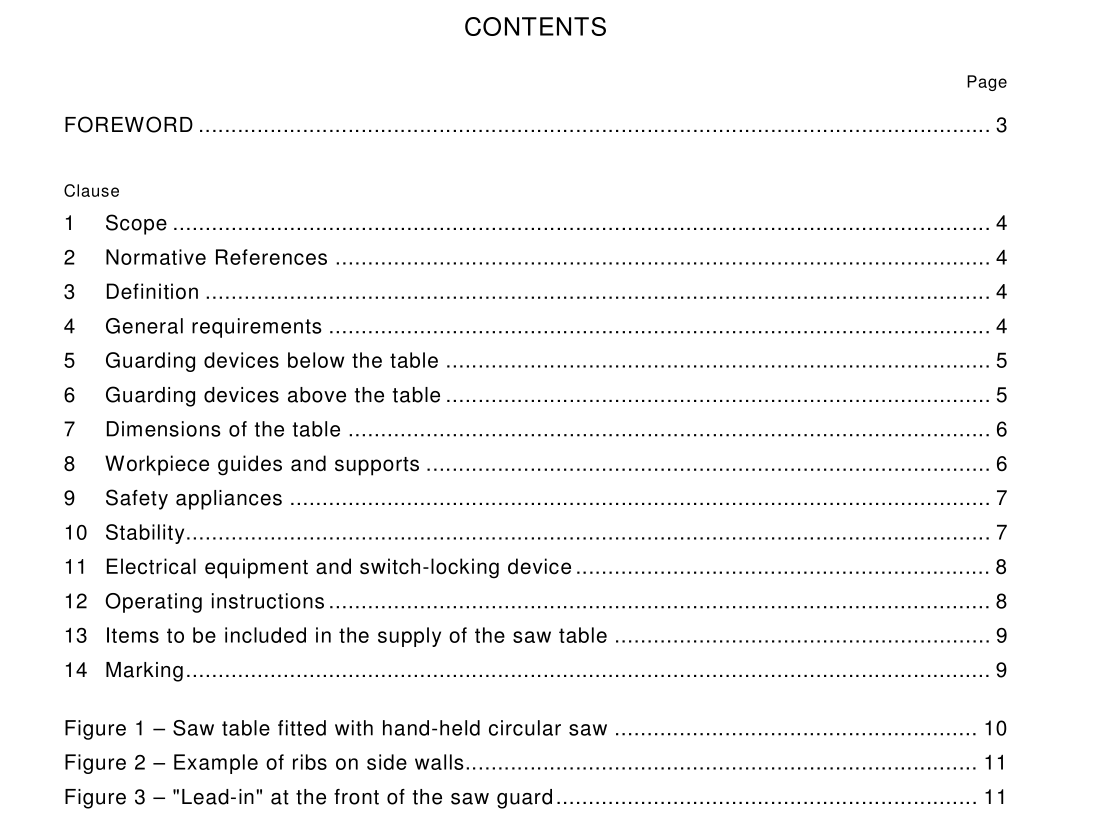IEC 61939 pdf download

IEC 61939 pdf download.Saw tables for use as saw benches – Tables for hand-held circular saws with a maximum saw-blade diameter of 315 mm – Safety requirements
4 General requirements
The saw table shall include the equipment needed to fasten the hand-held circular saw which is to be mounted on the table. The table shall be provided with means to positively locate and secure the circular saw in its operating position. Screw fixing shall be fitted with anti- loosening devices, e.g. locking washers. Compliance is checked by inspection.
5 Guarding devices below the table
It is assumed that circular saws installed in the saw tables for stationary use shall comply with IEC 60745-2-5. When the saw is mounted on the saw table, the guarding of the rim of the blade above the guide plate, as specified in the above standard, shall not be impaired at any depth of cut or angle which may be set. If the design of the table is such that the guide plate of the saw is not in contact with the table, the saw blade between the guide plate and the table shall be guarded by a fixed guard. Compliance is checked by inspection and by the use of the test probe “a” (see figure 105 in IEC 60745-2-5) to check accessibility of the saw blade teeth of all saws recommended by the manufacturer.
6 Guarding devices above the table
6.1 Saw guard A saw guard shall be provided to guard that portion of the blade above the table. This guard shall have the following characteristics: • The material from which the guard is made shall be such that in the event of contact between the guard and the revolving saw blade, the guard will not disintegrate, and the possibility of the saw blade disintegration or detachment of the teeth will be minimized. Examples of such materials are polycarbonate, wood and aluminium. On non-transparent guards, the line of the cut shall be indicated or shall be visible. • The guard shall encompass the saw blade when it is in its highest position on the table. • The side walls shall either have a minimum thickness of 6 mm or shall have internal ribs with minimum thickness of 3 mm designed to bear against the body of the saw blade in order to minimize the risk of damage to the guard (see figure 2). • The infeed end of the base of the saw guard shall have a “lead in” with maximum dimensions as shown in figure 3, in order to avoid mis-feeding, should the guard be incorrectly set or the workpiece be uneven. • The saw guard shall be mounted separately from the riving knife but integral with the saw table. The support for the guard shall not be in line with the riving knife. • The top guard shall cover the top and the sides of the saw blade and shall be capable of being raised and lowered so that when the saw table is fitted with the circular saw having the largest saw blade, the bottom edge of the guard can be raised to a minimum height of 50% of the length of the table slot above the uppermost saw teeth, and the guard can be lowered to table level. • The maximum inside width of the saw guard at its base shall be 40 mm, except on tables for circular saws which have the facility to cant the saw blade. • With the saw guard in its lowest position, the height of the saw blade shall be visible from the point at which the operator adjusts the saw blade height.









